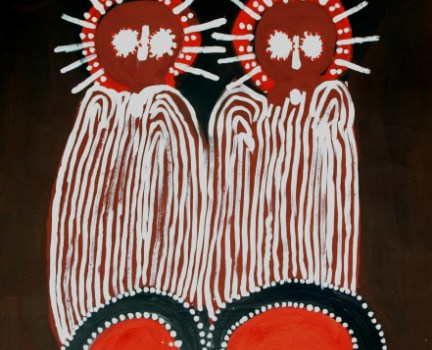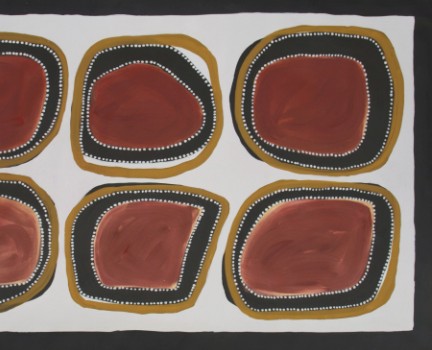Marking Stone Dreaming Jalala
Jack Dale Mengenen (c1920- 2013) lived all his life in the West Kimberley, spending much of his time working as a head stockman at Mt House Station on the Gibb River Road. Jack Dale was brought up in the Ngarinyin culture by his maternal grandfather and travelled widely over this part of the country, learning the ways of the land and visiting traditional sacred sites.
When he was an older man Jack Dale Mengenen began painting the stories from his remarkable memories of life in the Kimberley. During his lifetime the Kimberley had slowly progressed from being a frontier land to a vast cattle raising district and then finally to be connected to modern Australia.
Amongst the traditional stories that Jack Dale Mengenen painted was Jalala or marking stones. Jack Dale was very aware of cultural boundaries and the importance of people maintaining their places and their heritage. The point of the Jalala marking stones was to signify the marked boundaries between traditional lands. Jack Dale says: “The Jalala (Djalala) are markers from the Dreamtime. They are marking stones that divide our land from other people’s land. Ngarinyin country is to the east and Bunuba country to the south, and Unggumi country to the west. People have to stick to their boundaries. If you don’t know the country, you can follow the stones to the Wandjina.”
The Jalala stones are also a reminder to a person that they are approaching a sacred site or taboo area. These stones are sometimes placed near paintings of Wandjnas, the great Creator Ancestors whose painted images on the rock shelters of the West Kimberley are found at hundreds of spiritually important sites.
Jack Dale has included images of Jalala stones in a number of his major paintings. Sometimes the image of Jalala includes other levels of meaning, including in some paintings to represent the circling force of the whirlwind. These powerful winds are associated with the Wandjina when they precede the big storms that mark the on-set of the cyclone and rainy season. The artist is thereby making the association between the marking stones, the sacred sites of Wandjina, and the cycle of the Wet season rainstorms that replenish the land.
Jack Dale has also suggested that the Jalala stones were used during ceremonies to decipher whether particular events that had happened were associated with negative behaviour by individuals. There was the suggestion that the Law was being interpreted using the Jalala stones, when people gathered together to settle issues and establish cohesion and equilibrium within the group.
Jack Dale’s highly significant paintings give us a great insight into both traditional and working life in the Kimberley during a time of great change and upheaval. These paintings are a monument to a way of life that has mostly passed with the individuals who were part of Kimberley history during the 20th century.
Read More:
Back to Aboriginal Dreamtime Stories





